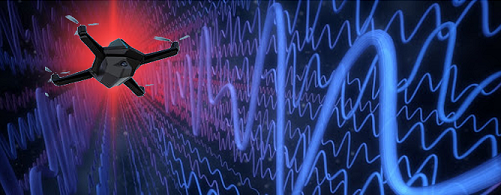[Editor’s Note: Army Mad Scientist is pleased to present our latest episode of The Convergence podcast, with the next installment of our series on How They Fight. This episode features Subject Matter Experts (SMEs) from the TRADOC G-2, Blue Path Labs, Center for New American Security (CNAS), CNA, and VAST-OSINT discussing How China Fights, exploring how our pacing threat conducts intelligentized warfare, maneuver, fires, information operations, cyber, and more! China’s global ambitions and increasing assertiveness, combined with its warfighting modernization efforts spanning materiel, organization, training, and personnel capabilities will enable them to contest us across all domains in Competition, Crisis, and Conflict. Read on (and listen!) to learn how our most technologically sophisticated adversary fights!]
[If the podcast dashboard is not rendering correctly for you, please click here to listen to the podcast.]
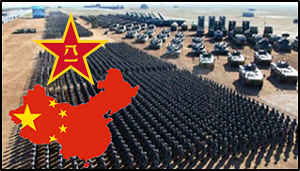 Over the past two decades, China has transformed its People’s Liberation Army (PLA) through a holistic approach — modernizing its weaponry, force structure, and approaches to warfare, to include operations in the cyber and space domains, while improving its professional military education. Although Russia remains a near-peer threat, China has ascended to become the United States’ lone pacing threat. The PLA’s momentous progress in warfighting capabilities and concepts, coupled with its whole-of-nation
Over the past two decades, China has transformed its People’s Liberation Army (PLA) through a holistic approach — modernizing its weaponry, force structure, and approaches to warfare, to include operations in the cyber and space domains, while improving its professional military education. Although Russia remains a near-peer threat, China has ascended to become the United States’ lone pacing threat. The PLA’s momentous progress in warfighting capabilities and concepts, coupled with its whole-of-nation 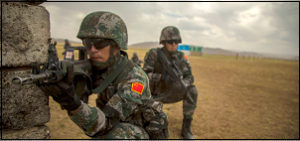 approach to competition, crisis, and conflict, enables it to challenge the United States across all domains and the Diplomatic, Information, Military, and Economic spheres.
approach to competition, crisis, and conflict, enables it to challenge the United States across all domains and the Diplomatic, Information, Military, and Economic spheres.
Army Mad Scientist interviewed the seven world-class SMEs regarding our near peer threat to learn How China Fights:
 Ian Sullivan serves as the Senior Advisor for Analysis and ISR to the Deputy Chief of Staff, G-2, at the U.S. Army Training and Doctrine Command (TRADOC G2). He is responsible for the analysis that defines and the narrative that explains the Army’s Operational Environment, which supports integration across doctrine, organization, training, materiel, leadership and education, personnel, facilities, and policy. Mr. Sullivan is a frequent and valued contributor to the Mad Scientist Laboratory, including the previous episode in this series, How Russia Fights.
Ian Sullivan serves as the Senior Advisor for Analysis and ISR to the Deputy Chief of Staff, G-2, at the U.S. Army Training and Doctrine Command (TRADOC G2). He is responsible for the analysis that defines and the narrative that explains the Army’s Operational Environment, which supports integration across doctrine, organization, training, materiel, leadership and education, personnel, facilities, and policy. Mr. Sullivan is a frequent and valued contributor to the Mad Scientist Laboratory, including the previous episode in this series, How Russia Fights.
Peter Wood is a program manager and defense analyst at Blue Path Labs, a strategic advisory firm. He previously edited China Brief, a publication of the Jamestown Foundation. He has an M.A. from the Hopkins-Nanjing Center for Chinese and American Studies (HNC) and a B.A. in Political Science from Texas Tech University. He is proficient in Chinese.
 Elsa B. Kania is an Adjunct Senior Fellow with the Technology and National Security Program at CNAS. Her research focuses on Chinese military strategy, military innovation, and emerging technologies. Her book, Fighting to Innovate, should be forthcoming with the Naval Institute Press in 2022. At CNAS, Ms. Kania has contributed to the Artificial Intelligence and Global Security Initiative and the “Securing Our 5G Future” program, while acting as a member of the Digital Freedom Forum and the research team for the Task Force on Artificial Intelligence and National Security. Ms. Kania is a Ph.D. candidate in Harvard University’s Department of Government. She is also a graduate of Harvard College and has received a Master of Arts in Government from Harvard University. Ms. Kania was a Boren Scholar in Beijing, China, and she maintains professional proficiency in Mandarin Chinese. She is a proclaimed Mad Scientist and valued contributor to the Mad Scientist Laboratory.
Elsa B. Kania is an Adjunct Senior Fellow with the Technology and National Security Program at CNAS. Her research focuses on Chinese military strategy, military innovation, and emerging technologies. Her book, Fighting to Innovate, should be forthcoming with the Naval Institute Press in 2022. At CNAS, Ms. Kania has contributed to the Artificial Intelligence and Global Security Initiative and the “Securing Our 5G Future” program, while acting as a member of the Digital Freedom Forum and the research team for the Task Force on Artificial Intelligence and National Security. Ms. Kania is a Ph.D. candidate in Harvard University’s Department of Government. She is also a graduate of Harvard College and has received a Master of Arts in Government from Harvard University. Ms. Kania was a Boren Scholar in Beijing, China, and she maintains professional proficiency in Mandarin Chinese. She is a proclaimed Mad Scientist and valued contributor to the Mad Scientist Laboratory.
 Kevin Pollpeter is a research scientist in the CNA China Studies Division. He is an internationally recognized expert on China’s space program and is widely published on Chinese national security issues, focusing on Chinese military modernization, China’s defense industry, and Chinese views on information warfare. His publications include China Dream, Space Dream: China’s Progress in Space Technologies and Implications for the United States; Planning for Innovation: Understanding China’s Plans for Technological, Energy, Industrial, and Defense Development; and “Chinese Writings on Cyberwarfare and Coercion,” in China and Cybersecurity: Espionage, Strategy, and Politics in the Digital Domain. A Chinese linguist, he holds an M.A. in international policy studies from the Monterey Institute of International Studies and is currently enrolled in a Ph.D. program at King’s College London.
Kevin Pollpeter is a research scientist in the CNA China Studies Division. He is an internationally recognized expert on China’s space program and is widely published on Chinese national security issues, focusing on Chinese military modernization, China’s defense industry, and Chinese views on information warfare. His publications include China Dream, Space Dream: China’s Progress in Space Technologies and Implications for the United States; Planning for Innovation: Understanding China’s Plans for Technological, Energy, Industrial, and Defense Development; and “Chinese Writings on Cyberwarfare and Coercion,” in China and Cybersecurity: Espionage, Strategy, and Politics in the Digital Domain. A Chinese linguist, he holds an M.A. in international policy studies from the Monterey Institute of International Studies and is currently enrolled in a Ph.D. program at King’s College London.
 Dr. Amanda Kerrigan is a Research Scientist in the China and Indo-Pacific Security Affairs Division at CNA, where her research has focused on Chinese developments in artificial intelligence (AI) and Chinese media responses to U.S. military operations and activities worldwide. Dr. Kerrigan holds a Ph.D. in China Studies from Johns Hopkins University School of Advanced International Studies, a Master’s degree in Chinese Politics and Diplomacy from Fudan University in Shanghai, and a Bachelor’s degree in Asian Studies from Georgetown University. She was a Fulbright Fellow in China from 2015-2016, studying protest and violence in China’s health care system. Fluent in Chinese, she spent four years living between mainland China and Taiwan. Her previous professional experiences include working in the China Practice at the Albright Stonebridge Group and with Johns Hopkins Medicine International.
Dr. Amanda Kerrigan is a Research Scientist in the China and Indo-Pacific Security Affairs Division at CNA, where her research has focused on Chinese developments in artificial intelligence (AI) and Chinese media responses to U.S. military operations and activities worldwide. Dr. Kerrigan holds a Ph.D. in China Studies from Johns Hopkins University School of Advanced International Studies, a Master’s degree in Chinese Politics and Diplomacy from Fudan University in Shanghai, and a Bachelor’s degree in Asian Studies from Georgetown University. She was a Fulbright Fellow in China from 2015-2016, studying protest and violence in China’s health care system. Fluent in Chinese, she spent four years living between mainland China and Taiwan. Her previous professional experiences include working in the China Practice at the Albright Stonebridge Group and with Johns Hopkins Medicine International.
 Doowan Lee is CEO and co-founder of VAST-OSINT, an AI startup. He builds data analytic tools to expose and analyze the provenance of disinformation and adversarial information operations by enriching and visualizing cyber data for content authentication. He is also a senior advisor to the Institute for Security and Technology (IST) and adjunct professor of politics at the University of San Francisco. He leverages emerging AI technologies to empower open society and support national security. He specializes in disinformation analysis and great power competition in the Information Environment. Before founding VAST-OSINT, he taught at the Naval Postgraduate School for more than eleven years as a faculty member and principal investigator. He was also featured in a previous podcast episode, Disinformation, Revisionism, and China.
Doowan Lee is CEO and co-founder of VAST-OSINT, an AI startup. He builds data analytic tools to expose and analyze the provenance of disinformation and adversarial information operations by enriching and visualizing cyber data for content authentication. He is also a senior advisor to the Institute for Security and Technology (IST) and adjunct professor of politics at the University of San Francisco. He leverages emerging AI technologies to empower open society and support national security. He specializes in disinformation analysis and great power competition in the Information Environment. Before founding VAST-OSINT, he taught at the Naval Postgraduate School for more than eleven years as a faculty member and principal investigator. He was also featured in a previous podcast episode, Disinformation, Revisionism, and China.
 Andrea Kendall-Taylor is a Senior Fellow and Director of the Transatlantic Security Program at CNAS. She works on national security challenges facing the United States and Europe, focusing on Russia, authoritarianism and threats to democracy, and the state of the Transatlantic alliance. Prior to joining CNAS, Ms. Kendall-Taylor served for eight years as a senior intelligence officer. From 2015 to 2018, she was Deputy National Intelligence Officer for Russia and Eurasia at the National Intelligence Council (NIC) in the ODNI. Prior to joining the NIC, Ms. Kendall-Taylor was a senior analyst at the CIA where she worked on Russia and Eurasia, the political dynamics of autocracies, and democratic decline. Ms. Kendall-Taylor is an adjunct professor at Georgetown University’s School of Foreign Service. Ms. Kendall-Taylor was also featured in the previous episode, How Russia Fights.
Andrea Kendall-Taylor is a Senior Fellow and Director of the Transatlantic Security Program at CNAS. She works on national security challenges facing the United States and Europe, focusing on Russia, authoritarianism and threats to democracy, and the state of the Transatlantic alliance. Prior to joining CNAS, Ms. Kendall-Taylor served for eight years as a senior intelligence officer. From 2015 to 2018, she was Deputy National Intelligence Officer for Russia and Eurasia at the National Intelligence Council (NIC) in the ODNI. Prior to joining the NIC, Ms. Kendall-Taylor was a senior analyst at the CIA where she worked on Russia and Eurasia, the political dynamics of autocracies, and democratic decline. Ms. Kendall-Taylor is an adjunct professor at Georgetown University’s School of Foreign Service. Ms. Kendall-Taylor was also featured in the previous episode, How Russia Fights.
In our interview with the aforementioned SMEs, we explore How China Fights, to include intelligentized warfare, maneuver, fires, information operations, cyber, and more! The following bullet points highlight key insights from our interview:
-
-
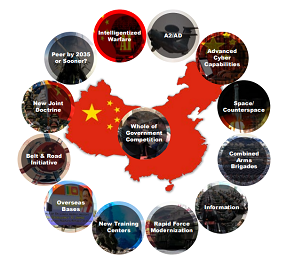 Beginning in 2004, China’s PLA undertook a major modernization effort to reinvent itself as a rival to the United States. It invested in extensive technology development, undertook major force restructuring, and created new, specialized units for advanced warfare. Though the PLA lacks combat experience, it has become progressively more assertive in competition.
Beginning in 2004, China’s PLA undertook a major modernization effort to reinvent itself as a rival to the United States. It invested in extensive technology development, undertook major force restructuring, and created new, specialized units for advanced warfare. Though the PLA lacks combat experience, it has become progressively more assertive in competition.
-
-
-
 China has completed extensive research and development in artificial intelligence (AI) and autonomous systems. Specifically, China will use this technology to support drones across all military operations, including combat and logistical support. China is now the United States’ most technologically sophisticated adversary, though its concentration on this “science” of warfare may be at the expense of the “art” of battle, or the focus on training creative, resilient human forces.
China has completed extensive research and development in artificial intelligence (AI) and autonomous systems. Specifically, China will use this technology to support drones across all military operations, including combat and logistical support. China is now the United States’ most technologically sophisticated adversary, though its concentration on this “science” of warfare may be at the expense of the “art” of battle, or the focus on training creative, resilient human forces.
-
-
-
 China will also leverage its AI proficiency in “intelligent warfare,” integrating machines in military decision making. This strategy will shift warfare to the key cyber and space domains and increase its emphasis on obtaining high-quality military data.
China will also leverage its AI proficiency in “intelligent warfare,” integrating machines in military decision making. This strategy will shift warfare to the key cyber and space domains and increase its emphasis on obtaining high-quality military data.
-
-
-
-

PLA SSF shoulder patch In its modernization campaign, China created a Strategic Support Force (SSF) for information warfare, space operations, and cyber activities. The consolidation of these capabilities demonstrates China’s perception that these will be the decisive domains in future warfare. Further, documentation demonstrates that China sees information operations as a regular, rather than irregular, warfare technique.
-
-
-
-
-

China Trifold (obverse) / Source: TRADOC G-2 — check it out here! China has also sought to fully integrate itself into the global economy and digital infrastructure through programs like the Belt and Road Initiative (BRI). This effort increased the strength and resilience of its economy, portrayed China as a willing and capable development partner, and provided itself with increased access to operation spaces for future systems confrontations.
-
-
-
-
-
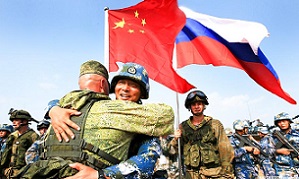
Chinese and Russian marines embrace in Zhanjiang, South China’s Guangdong province, during Exercise “Joint Sea 2016” / Source: www.chinadaily.com.cn; Photo by Xinhua Though China’s relationship with Russia is limited and transactional, the rate of cooperation between the two nations has increased in recent years. They are increasingly aligned on policy goals such as countering U.S. influence and democracy promotion, and seek to combine Chinese capital with Russian talent to fully advance their respective international standings.
-
-
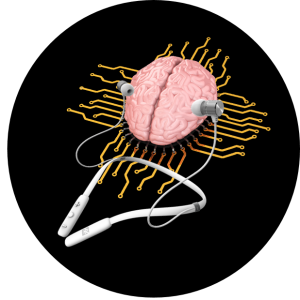
Stay tuned to the Mad Scientist Laboratory for our next episode of The Convergence podcast “Through Soldiers’ Eyes: The Future of Ground Combat,” featuring subject matter experts — military analysts, combat veterans, and combat reporters — discussing their experiences in modern warfare at the “bleeding edge” of battle, the future of conflict, and the requirements and challenges facing future ground warfighters.
Learn more about China as our Pacing Threat in the following TRADOC G-2 content:
ATP 7-100.3, Chinese Tactics; People’s Liberation Army Ground Forces Quick Reference Guide; China Trifold; the China products page; and information on PLA weapon systems accessed via the Worldwide Equipment Guide (WEG) on the OE Data Integration Network (ODIN).
… explore the following Mad Scientist Laboratory China content:
The Operational Environment (2021-2030): Great Power Competition, Crisis, and Conflict, along with its source document
China’s PLA Modernization through the DOTMLPF-P Lens, by Dr. Jacob Barton
“Intelligentization” and a Chinese Vision of Future War
Competition and Conflict in the Next Decade
Disrupting the “Chinese Dream” – Eight Insights on how to win the Competition with China
Competition in 2035: Anticipating Chinese Exploitation of Operational Environments
Disinformation, Revisionism, and China with Doowan Lee and associated podcast
China and Russia: Achieving Decision Dominance and Information Advantage, by Ian Sullivan
The PLA and UAVs – Automating the Battlefield and Enhancing Training
A Chinese Perspective on Future Urban Unmanned Operations
China: “New Concepts” in Unmanned Combat and Cyber and Electronic Warfare
The PLA: Close Combat in the Information Age and the “Blade of Victory”
… and check out the following additional content on China:
China’s Military Civil Fusion Strategy: A View from Chinese Strategists, by Alex Stone and Peter Wood
People’s Liberation Army: Army Campaign Doctrine in Transition by Kevin McCauley
THE PLA BEYOND BORDERS Chinese Military Operations in Regional and Global Context, edited by Joel Wuthnow, Arthur S. Ding, Phillip C. Saunders, Andrew Scobell, and Andrew N.D. Yang
Deciphering the PLA’s New Joint Doctrine: A Conversation with Dr. David Finkelstein, a podcast by our colleagues at the China Power Project at the Center for Strategic and International Studies (CSIS)
>>> REMINDER: Army Mad Scientist Fall / Winter Writing Contest: Crowdsourcing is an effective tool 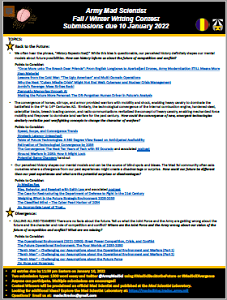 for harvesting ideas, thoughts, and concepts from a wide variety of interested individuals, helping to diversify thought and challenge conventional assumptions. Army Mad Scientist seeks to crowdsource the intellect of the Nation (You!) with our Fall / Winter Writing Contest’s two themes — Back to the Future and Divergence – check out the associated writing prompts in the contest flyer and announcement, then get busy crafting your submissions — entries will be accepted in two formats:
for harvesting ideas, thoughts, and concepts from a wide variety of interested individuals, helping to diversify thought and challenge conventional assumptions. Army Mad Scientist seeks to crowdsource the intellect of the Nation (You!) with our Fall / Winter Writing Contest’s two themes — Back to the Future and Divergence – check out the associated writing prompts in the contest flyer and announcement, then get busy crafting your submissions — entries will be accepted in two formats:
Written essay (no more than 1500 words, please!)
Tweet @ArmyMadSci, using either #MadSciBacktotheFuture or #MadSciDivergence
We will pick a winner from each of these two formats!
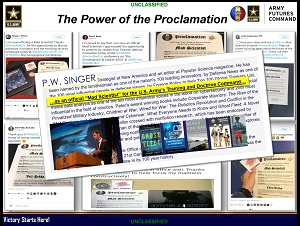 Contest Winners will be proclaimed official Mad Scientists and be featured in the Mad Scientist Laboratory. Semi-finalists of merit will also be published!
Contest Winners will be proclaimed official Mad Scientists and be featured in the Mad Scientist Laboratory. Semi-finalists of merit will also be published!
DEADLINE: All entries are due NLT 11:59 pm Eastern on January 10, 2022!
Any questions? Don’t hesitate to reach out to us — send us an eMail at: madscitradoc@gmail.com
Disclaimer: The views expressed in this blog post do not necessarily reflect those of the Department of Defense, Department of the Army, Army Futures Command (AFC), or Training and Doctrine Command (TRADOC).



 targeted by our adversaries. The advent of the Internet of Things (IoT) and the proliferation of autonomy means a plethora of ever-smaller wireless internet and cellular antennae, paired with smaller and more prolific sensors, are embedded across public and industrial infrastructure. This web of networked sensors has, per Chris O’Connor in his superlative post
targeted by our adversaries. The advent of the Internet of Things (IoT) and the proliferation of autonomy means a plethora of ever-smaller wireless internet and cellular antennae, paired with smaller and more prolific sensors, are embedded across public and industrial infrastructure. This web of networked sensors has, per Chris O’Connor in his superlative post  Russia and China present a hemispheric threat to the U.S., having invested heavily in
Russia and China present a hemispheric threat to the U.S., having invested heavily in  — controlling electrical grids, water and sewage supply and treatment facilities, mass transit and rail, traffic controls, telecom and IT networks and systems, and more — lack appropriate cybersecurity protocols and defense capabilities to fend off threats from extraction tools, arbitrary code attacks (RCE), and
— controlling electrical grids, water and sewage supply and treatment facilities, mass transit and rail, traffic controls, telecom and IT networks and systems, and more — lack appropriate cybersecurity protocols and defense capabilities to fend off threats from extraction tools, arbitrary code attacks (RCE), and  advanced, automated systems (e.g., NOLAlytics in New Orleans, Metro21 Project in Pittsburgh) require increased connectivity and data storage capacity and capabilities – often relying on cloud services – which provides an opening for
advanced, automated systems (e.g., NOLAlytics in New Orleans, Metro21 Project in Pittsburgh) require increased connectivity and data storage capacity and capabilities – often relying on cloud services – which provides an opening for  Hospitals and medical centers are especially vulnerable to ransomware and cyber-attacks that compromise sensitive patient data, critical life support systems, and operating capabilities.
Hospitals and medical centers are especially vulnerable to ransomware and cyber-attacks that compromise sensitive patient data, critical life support systems, and operating capabilities.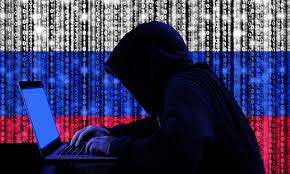 attack on Ukraine spilled beyond its target to inflict massive economic damage worldwide, crippling international shipping giant Maersk and causing an estimated $10 billion in economic damage. Russia had launched similar attacks previously — against Estonia in 2007 and Ukraine in 2015.
attack on Ukraine spilled beyond its target to inflict massive economic damage worldwide, crippling international shipping giant Maersk and causing an estimated $10 billion in economic damage. Russia had launched similar attacks previously — against Estonia in 2007 and Ukraine in 2015.
 While
While 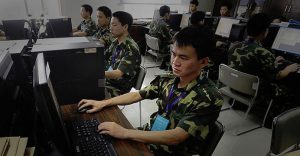 China continues to build up a substantial
China continues to build up a substantial  According to an
According to an 
 Attacks on or sabotage of
Attacks on or sabotage of technology, exploiting our inherent biases and
technology, exploiting our inherent biases and 
 The Chief of Staff for the Army placed “People First” among the Army’s priorities.
The Chief of Staff for the Army placed “People First” among the Army’s priorities. If the Army’s human dimension meets the mission but does not also meet the needs of people, then the Army is not successful. This requires the broader People approach integrating holistic health and fitness, cohesive teams, removing unnecessary systematic barriers to individual success, and providing resources for Soldiers to meet their maximum potential. In doing so, we live up to our Army’s and Nation’s values, while ensuring mission success.
If the Army’s human dimension meets the mission but does not also meet the needs of people, then the Army is not successful. This requires the broader People approach integrating holistic health and fitness, cohesive teams, removing unnecessary systematic barriers to individual success, and providing resources for Soldiers to meet their maximum potential. In doing so, we live up to our Army’s and Nation’s values, while ensuring mission success. What does it mean to put People first in the 2035 time frame? How do advances in technology and society provide more opportunities and challenges?
What does it mean to put People first in the 2035 time frame? How do advances in technology and society provide more opportunities and challenges? Army Mad Scientist will feature the winning submission and author in a future Mad Scientist Laboratory blog post. Additionally, we will compile it, along with other submissions of merit, and provide copies to Senior Army Leadership attending the Army People Synchronization Conference in January 2022!
Army Mad Scientist will feature the winning submission and author in a future Mad Scientist Laboratory blog post. Additionally, we will compile it, along with other submissions of merit, and provide copies to Senior Army Leadership attending the Army People Synchronization Conference in January 2022!
 The rapid payload integration center crew watched as the three reusable rocket boosters landed nearly simultaneously across from the refurbish-assembly building. Fantails of chemical foam
The rapid payload integration center crew watched as the three reusable rocket boosters landed nearly simultaneously across from the refurbish-assembly building. Fantails of chemical foam erupted from un-manned ground vehicles and a mobile recovery crane lurched toward the scene. The launch operations center director, Alex,
erupted from un-manned ground vehicles and a mobile recovery crane lurched toward the scene. The launch operations center director, Alex,  rubbed the temples of his balding head. This was a record fast turnaround for reusable boosters for them. Brussels was asking his team to repeat this feat two more times.
rubbed the temples of his balding head. This was a record fast turnaround for reusable boosters for them. Brussels was asking his team to repeat this feat two more times. This was a key wartime effort. The conflict in space began about six years ago among the expected belligerents. No one seemed surprised that it started. What surprised everyone is how tediously slow it unfolded and that it is still dragging on six years later. War in space was not the decisive catastrophe of
This was a key wartime effort. The conflict in space began about six years ago among the expected belligerents. No one seemed surprised that it started. What surprised everyone is how tediously slow it unfolded and that it is still dragging on six years later. War in space was not the decisive catastrophe of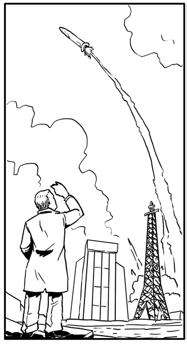 It had more in common with the positional trench warfare of the First World War than 20th century science fiction. One of Alex’s ancestors fought in World War I, and now he serves as an officer in the French Space Force. Alex sees satellites launched to block other satellites to block other satellites in seemingly infinite recursion. Some orbital regimes were now so densely occupied that some of Alex’s handiwork was visible from Earth. In the late evening he could already see the milky band across the sky that was the geo belt.
It had more in common with the positional trench warfare of the First World War than 20th century science fiction. One of Alex’s ancestors fought in World War I, and now he serves as an officer in the French Space Force. Alex sees satellites launched to block other satellites to block other satellites in seemingly infinite recursion. Some orbital regimes were now so densely occupied that some of Alex’s handiwork was visible from Earth. In the late evening he could already see the milky band across the sky that was the geo belt. 
 The low-profile semi-submersibles slipped out of the well deck of the converted bulk cargo ship under cloud cover and sliced through white caps towards the shipping lane. The Chinese task force charged with this zone was stretched thin, attempting to counter privateers, “flying circus” air raids from Australia, and policing embargo violations from the Americas. Darren piloted the lead semi-submersible in the
The low-profile semi-submersibles slipped out of the well deck of the converted bulk cargo ship under cloud cover and sliced through white caps towards the shipping lane. The Chinese task force charged with this zone was stretched thin, attempting to counter privateers, “flying circus” air raids from Australia, and policing embargo violations from the Americas. Darren piloted the lead semi-submersible in the  the target area while avoiding detection. Soon the wolfpack came into primary sensor range of two massive
the target area while avoiding detection. Soon the wolfpack came into primary sensor range of two massive each semi-submersible deployed their large slow-moving torpedo mines. The wolfpack then dispersed to make their way back to their mothership independently to confound post-strike analysis by the
each semi-submersible deployed their large slow-moving torpedo mines. The wolfpack then dispersed to make their way back to their mothership independently to confound post-strike analysis by the 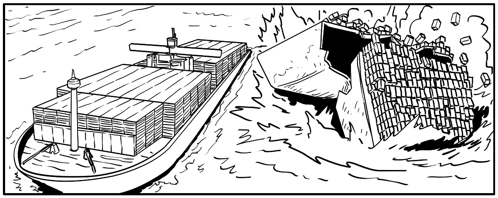
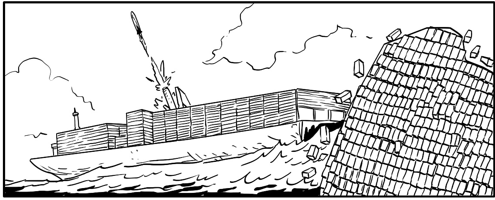
 John pressed up against the fence to watch the two unmanned refuelers taxi down the runway and quickly pull into makeshift hardened aircraft shelters on the apron. The great powers are fighting a regional
John pressed up against the fence to watch the two unmanned refuelers taxi down the runway and quickly pull into makeshift hardened aircraft shelters on the apron. The great powers are fighting a regional 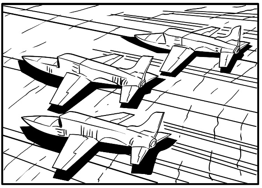 Advanced allied strike aircraft would land in short order, quickly rearm, refuel, and sortie on mission. They would attack enemy aircraft, insurgent missile batteries, and merchant ships full of shipping containers. Those containers would occasionally wash ashore or be towed in by fishing boats to be plundered.
Advanced allied strike aircraft would land in short order, quickly rearm, refuel, and sortie on mission. They would attack enemy aircraft, insurgent missile batteries, and merchant ships full of shipping containers. Those containers would occasionally wash ashore or be towed in by fishing boats to be plundered.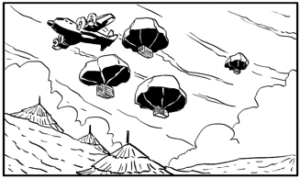 John’s ancestors worshipped cargo. During the Second World War, his people witnessed cargo airdropped off course and took it for blessings from the gods. Now, of course, most people know exactly where cargo comes from. But the cargo
John’s ancestors worshipped cargo. During the Second World War, his people witnessed cargo airdropped off course and took it for blessings from the gods. Now, of course, most people know exactly where cargo comes from. But the cargo  faith is about more than just shipping containers. The return of the importance of cargo to the lives of people in his community has led to a renaissance of the folk religion. Like their ancestors before them, the people in John’s community built makeshift airfields inland from the real one. They built life-size replicas of advanced American fighters out of bamboo, scrap metal, and
faith is about more than just shipping containers. The return of the importance of cargo to the lives of people in his community has led to a renaissance of the folk religion. Like their ancestors before them, the people in John’s community built makeshift airfields inland from the real one. They built life-size replicas of advanced American fighters out of bamboo, scrap metal, and  fiberglass siding. Maybe this was partly a sincere religious tradition and partly a practical matter to convince the Flying Circus it was safe to return.
fiberglass siding. Maybe this was partly a sincere religious tradition and partly a practical matter to convince the Flying Circus it was safe to return.
 The massive armored vehicle rolled to a stop and the rear hatch opened to a dark and quiet neighborhood. Feng is a PLA Soldier on a four-month rotation to Tanzania. There is fighting and violence, but
The massive armored vehicle rolled to a stop and the rear hatch opened to a dark and quiet neighborhood. Feng is a PLA Soldier on a four-month rotation to Tanzania. There is fighting and violence, but 
 tower bristling with polygonal antennas and began walking towards the gated perimeter warning lights. The air smelled of burnt plastic and raw sewage. Feng’s section chief remained in the vehicle to provide security. He extended the armored vehicle’s sensor mast and began scanning rooflines, looking for indicators that they were being watched. There were at least three insurgent groups active in this area.
tower bristling with polygonal antennas and began walking towards the gated perimeter warning lights. The air smelled of burnt plastic and raw sewage. Feng’s section chief remained in the vehicle to provide security. He extended the armored vehicle’s sensor mast and began scanning rooflines, looking for indicators that they were being watched. There were at least three insurgent groups active in this area. Feng did not make it to the gate before the explosives detonated in a carefully
Feng did not make it to the gate before the explosives detonated in a carefully  surged into the air and landed in a cloud of debris. The structure groaned and began to topple, slowly at first and then rapidly– collapsing to the ground.
surged into the air and landed in a cloud of debris. The structure groaned and began to topple, slowly at first and then rapidly– collapsing to the ground. The Chinese Soldier quickly grabbed his bag of tools and ran back to the waiting armored vehicle. There in the vehicle he jumped into the remote weapons station and assured his chief he was okay.
The Chinese Soldier quickly grabbed his bag of tools and ran back to the waiting armored vehicle. There in the vehicle he jumped into the remote weapons station and assured his chief he was okay.

 him. Beijing has now officially banned superlongevity treatments within China, but the Chairman and other Chinese elites continue to seek it out surreptitiously. Publicly, Beijing authorities express grave concern about superlongevity technology from the West which allows the wealthy to accumulate even larger fortunes over multiple natural human lifetimes.
him. Beijing has now officially banned superlongevity treatments within China, but the Chairman and other Chinese elites continue to seek it out surreptitiously. Publicly, Beijing authorities express grave concern about superlongevity technology from the West which allows the wealthy to accumulate even larger fortunes over multiple natural human lifetimes.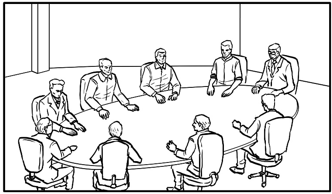 The Central Military Commission members sat around an elegant circular wooden conference table. They all began their rehearsed performance for the videographer/historian from the state-controlled media, the committee listening intently to the Chairman’s lecture. The scene was captured and the videographer left the committee to its real work– the operation to kill the so-called Caliph of the New Islamic State.
The Central Military Commission members sat around an elegant circular wooden conference table. They all began their rehearsed performance for the videographer/historian from the state-controlled media, the committee listening intently to the Chairman’s lecture. The scene was captured and the videographer left the committee to its real work– the operation to kill the so-called Caliph of the New Islamic State. The New Islamic State was notoriously responsible for the port explosion that killed over 10,000 in Shanghai. Much like the old Islamic State, for some Wahhabi Muslims, the mere existence of a credible Caliph with formal control over territory activated tenets of Islamic Law which lay dormant for hundreds of years.
The New Islamic State was notoriously responsible for the port explosion that killed over 10,000 in Shanghai. Much like the old Islamic State, for some Wahhabi Muslims, the mere existence of a credible Caliph with formal control over territory activated tenets of Islamic Law which lay dormant for hundreds of years. Beijing’s strategic manhunt aimed to eliminate the Caliph and revert the ideology of that demographic back to its peaceful state. The human who was the physical Caliph was killed ten years ago outside a religious school in Pakistan.
Beijing’s strategic manhunt aimed to eliminate the Caliph and revert the ideology of that demographic back to its peaceful state. The human who was the physical Caliph was killed ten years ago outside a religious school in Pakistan. The Caliph speaking in the video clip in front of them today was an
The Caliph speaking in the video clip in front of them today was an 




 aircraft carrier battle group, the mothership might also be incorporated into larger groups of manned and unmanned systems that can provide support, such as air and missile defenses.
aircraft carrier battle group, the mothership might also be incorporated into larger groups of manned and unmanned systems that can provide support, such as air and missile defenses.